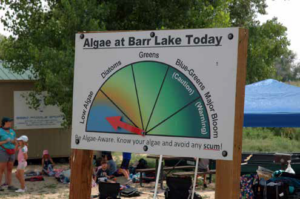“Lakespert” – Algal rating system
Steve Lundt, CLM
“…signs, signs, everywhere a sign…”

Figure 1. Algae awareness rating sign at Barr Lake State Park (Brighton, Colorado).
And the lake sign should be an “Algalmeter.” Yes, an Algalmeter. I do get tired of signs, especially when I visit a beautiful lake, but I have recently created and installed an algal rating system at a local state park (Figure 1). I based it on the National Fire Danger Rating System (NFDRS) and incorporated it with my lake monitoring events to help with public safety and awareness. Harmful algal blooms are important to understand, control, and are not well understood by the public. Thus, the need for yet another sign.
It seems to me that harmful algal blooms are topical news fillers during the heat of the summer and are then quickly forgotten. This needs to change. Algae awareness is important and needs to be in the forefront continuously. Cyanobacteria can grow year-round, and cultural eutrophication is an everyday topic for lake professionals everywhere.
An algae-awareness sign can educate the public all year long and become a part of the outdoor culture. If you want to camp during a drought, you should know if you can have a campfire before you leave. Same thing for lakes. If you want to go boating during the peak harmful algal bloom season, you should know if you can wakeboard before you pack up. Some kind of permanent sign that shows current and/or projected algae conditions will help keep the public safe and informed.
It was 1972 when the NFDRS became operational nationwide. Coincidentally, that same year the Clean Water Act started. Canada also has their own uniform, consistent rating system that keeps the public informed. It is time for lakes to have a similar program for harmful algal blooms. We have the water quality data, models, and often the historical algal patterns. The public understands scales, meters, and colored tiers. It is time for the Algalmeter.
Public awareness and education are key to any lake management program. This prevents the summertime panic when there are reports of sick dogs, closed beaches, and “DANGER” signs going up. Strategically placed algae rating signs can keep people informed and prepared. Along with a permanent sign, you can include postcards to park visitors explaining the various types of algae. You can create mascots to help spread the message. Just think what Smokey Bear has done for the forest fire awareness program. Now imagine a cute fish pointing a pectoral fin at you saying,
“only you … can prevent harmful algal blooms.”
“… blockin’ out the scenery, breakin’ my mind…”
The Algalmeter can break down how people think about lakes and increase their knowledge about harmful algal blooms and algae in general. Do it consistently but do not block the scenery. Be algae- aware and enjoy Lakes Appreciation Month.
 Steve Lundt, Certified Lake Manager, has monitored and worked to improve water quality at Barr Lake (Denver, Colorado) for the past 19 years. Steve is active with the Colorado Lake & Reservoir Management Association and is a past Region 8 director for NALMS and an active member since 1998.
Steve Lundt, Certified Lake Manager, has monitored and worked to improve water quality at Barr Lake (Denver, Colorado) for the past 19 years. Steve is active with the Colorado Lake & Reservoir Management Association and is a past Region 8 director for NALMS and an active member since 1998.

